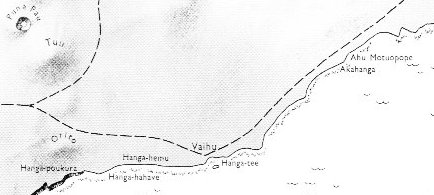4. We have to start counting from Nga Kope Ririva in order to give number 5 to Te Kioe Uri:
In spite of numbers being indisputable and signs of order they are not easy to handle, they are complex creatures (like life in general). To use numbers in order to reach order, so to say, is not advisable, you could easily delude yourself. The right numbers should intstead be there at the end of the work, otherwise you must have gone wrong somewhere. Therefore it cannot be an argument to give number 5 to Te Kioe Uri in the way presented above, it is a completely worthless argument. Let us instead see where Barthel has located Te Kioe Uri geographically on the island. It ought to be a place somewhere in the middle between Te Pu Mahore and Te Pou (or expressed in time halfway up to full moon):
Akahanga (at right on the map) is a bay of rest according to its name, and it ought to be the 'anchor place' of the season of growth ('spring', i.e. Waxing Moon). It is the 9th station if we count from Te Pu Mahore. According to the informant of Barthel (The Eighth Land, p. 37) the 4 first kuhane stations on the island are located close to Rano Kau, while those following are located along the southern coast: "The starting point of all lists of names [of the kuhane stations, not only the list in Manuscript E], attributed directly or indirectly to Hau Maka, are the three islets off the southwestern cape of Easter Island; this is traditionally the place where Hotu Matua later arrives in his double canoe. Historically, the channel between Orongo and Motu Nui was the center of the cult of the birdman, and the annual race from Orongo to Motu Nui was the high point in the life of the Easter Islander during pre-missionary times. From there, the path of the dream soul leads to the cliffs below the lowest edge of the rim of the crater Te Karikari, reaches Rano Kau, which is given the name 'dark abyss' (poko uri), passes the side crater Manavai and the place of the 'dark rat' (kioe uri) in the hinterland of Vinapu, and finally follows the whole southeastern shoreline." If his informant was right, then we ought to regroup the stations into 4 + 3:
Maybe 'the dark rat' is being born from the volcano Rano Kau - volcanoes do generate fire at some times. |
|||||||||||||||||||||||||||||
